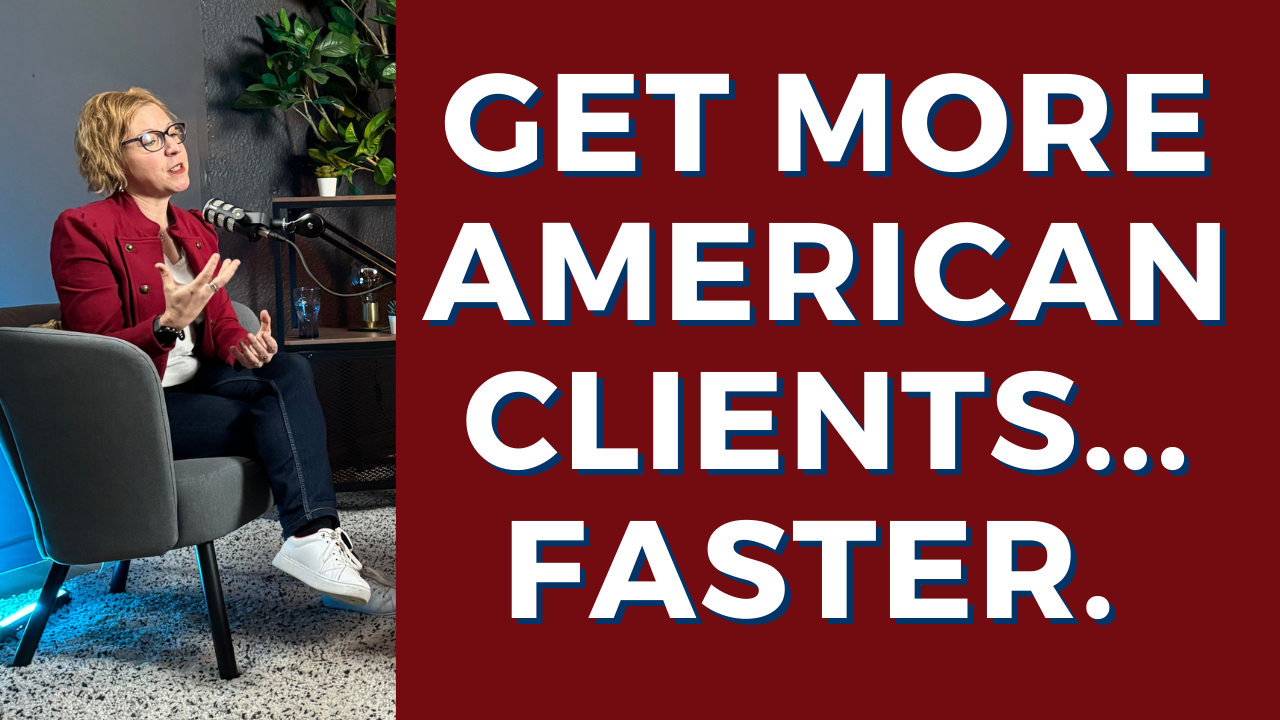

Getting U.S. clients can feel hard, even when you know your work is great.
You might ask yourself, “Why aren’t they choosing me?”
The truth is, U.S. clients think and work differently.
They want quick results, clear communication, and confidence from the people they hire.
If you keep using the same strategies you use in your home market, you’ll miss out.
But when you understand what U.S. clients expect, everything changes.
Let’s look at what’s holding you back and how you can fix it to get more U.S. clients—faster.
1. The Real Problem Isn’t What You Think
Many European entrepreneurs believe that their skills and services will speak for themselves.
If it works at home, why wouldn’t it work in the U.S.?
But the truth is, American clients think and act differently—and that can be a big problem if you don’t adapt.
For example, in Europe, business relationships often take time to build.
Trust grows slowly.
You might spend a lot of time talking, getting to know each other, and building comfort before you even talk about work.
But in the U.S., clients want results—quickly.
They care about solving their problem and seeing clear benefits.
If your pitch or your website focuses too much on the process instead of the results, American clients will lose interest.
Another issue? Confidence.
In Europe, modesty is seen as a strength.
You might think that listing your achievements or successes sounds like bragging.
But in the U.S., confidence is essential.
If you don’t clearly say what you can do—and how well you do it—U.S. clients will wonder if you are really the right person to help them.
Lastly, speed matters.
Americans expect fast replies, quick decisions, and clear answers.
If you don’t respond quickly to emails or messages, they may move on to someone else.
They don’t think you are rude—they just think you aren’t serious about doing business with them.
The problem isn’t your work or skills.
It’s the way you’re showing your value. U.S. clients need to see results, confidence, and speed to trust you.
When you understand these differences, you can start to connect with American clients in a way that works.
2. Three Common Obstacles Holding You Back
If you’re struggling to get U.S. clients, you’re not alone.
Many European entrepreneurs face the same challenges.
The good news?
These problems are fixable.
Let’s look at three common obstacles that might be standing in your way.
Obstacle 1: Misreading Cultural Differences
In Europe, being polite and formal is often seen as professional. But in the U.S., people prefer clear, direct, and simple communication. If your message feels too complicated or indirect, American clients might not understand what you’re offering—or why they should care. They want to know: “What’s in it for me?” If you don’t answer that right away, they’ll lose interest.
Obstacle 2: Fear of Self-Promotion
Many European entrepreneurs feel uncomfortable promoting themselves. You might think, “If I’m good at what I do, people will notice.” But in the U.S., if you’re not visible, you’re invisible. Clients need to see proof of your success—results, testimonials, and clear examples of your expertise. This isn’t bragging; it’s showing that you’re confident and capable.
Obstacle 3: Treating Networking as a Transaction
In the U.S., networking isn’t just about finding your next client. It’s about building long-term relationships. If you show up to events only focused on making a sale, you’ll come across as pushy. Americans value genuine connections. Take the time to get to know people, ask about their needs, and build trust. Over time, these relationships can lead to referrals, partnerships, and big opportunities.
These obstacles might feel overwhelming, but they’re not permanent.
By understanding U.S. cultural expectations and adapting your approach, you can start connecting with American clients in a way that feels natural and effective.
3. A New Way to Think About Winning U.S. Clients
To succeed with U.S. clients, you need to change the way you think about your business.
It’s not just about what you do—it’s about how you show your value in a way that makes sense to them.
Here are three mindset shifts that can help.
Shift 1: Focus on Outcomes, Not Processes
American clients care about results. They don’t want to hear all the details about how you’ll solve their problem—they just want to know that you can. For example, instead of saying, “I offer digital marketing services,” say, “I help companies grow their sales by 50%.” Show them the outcome they’ll get if they work with you.
Shift 2: Be Confident and Visible
In the U.S., confidence equals trust. If you don’t believe in your own skills, why should they? Show your expertise by sharing success stories, testimonials, and real results. Be present on platforms like LinkedIn, where your target clients are. Post regularly, share insights, and let them see that you’re the expert they’ve been looking for.
Shift 3: Think Long-Term Relationships, Not Quick Sales
Networking in the U.S. is about more than making a sale. It’s about building trust over time. Attend events, join online communities, and connect with people in your industry. Focus on being helpful and supportive. Over time, these relationships will turn into partnerships, referrals, and opportunities that you couldn’t have planned for.
Winning U.S. clients isn’t just about working harder—it’s about working smarter.
When you shift your mindset to focus on results, confidence, and relationships, you’ll start to see real progress.
The U.S. market isn’t as intimidating as it seems.
With the right approach, it can be a place where your business grows faster than ever.
Conclusion
Winning U.S. clients doesn’t have to feel impossible.
The key is to understand their expectations and adapt your approach.
Focus on results, show confidence, and build real relationships.
When you align with what U.S. clients value, you’ll stand out as the expert they need.
You already have the skills and experience—now it’s time to communicate them in a way that works across the Atlantic.
Take one step today: rethink your message, show your value, and start building connections.
The U.S. market is full of opportunities, and you’re ready to make the most of them.
→ Want to get more American clients? Go here: https://www.transatlantia.com/transatlantic-entrepreneur-webinar
→ Want to transform your LinkedIn profile into an American client magnet? Go here: https://www.christinarebuffetcourses.fr/american-client-magnet-course
If you’re new here, my name is Christina Rebuffet-Broadus.
I’m the founder of TransAtlantia (https://www.transatlantia.com/) a consultancy & training company that helps European service providers, solopreneurs and agencies attract American clients and make more revenue in the American market.
We do this by breaking down the cultural, language, and mental barriers that are preventing you from getting American clients.
You position yourself as a reference in your industry, and get more American clients faster and more easily.
Over the past 20 years, I’ve helped 1,000+ European businesses generate over 10 billion euros in revenue thanks to American clients.
My clients, including prestigious names like Cartier, Dior, Zeiss, and Teledyne E2V, and also a range of small businesses and solopreneurs.
Some impressive results they’ve seen:
→ Winning an $8 billion contract with Houston Airport by adapting their negotiation style.
→ Raising $42 million from American VCs and investors.
→ Achieving a 36x ROI by adapting a France-based business coaching program to suit an international market
To learn how we can help you get more American clients for your business, start by watching my insider secrets webinar at https://www.transatlantia.com/transatlantic-entrepreneur-webinar




